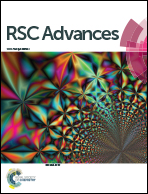Hybrid nanofibers from biodegradable polylactide and polythiophene for scaffolds
Abstract
Hybrid scaffolds constituted of polylactide (PLA) as a biodegradable polymer and poly(3-thiophene methyl acetate) (P3TMA) as an electroactive polymer were prepared and studied. Both polymers had a similar solubility and consequently could be easily electrospun using a common solvent. Electrospinning operational parameters were optimized to get continuous micro/nanofibers with a homogeneous diameter that ranged between 600 and 900 nm depending on the PLA–P3TMA ratio. Electrospinning was only effective when the P3TMA content was at maximum 50 wt%. The incorporation of P3TMA slightly decreased the fibre diameter, led to smoother fibre surfaces and gave rise to some heterogeneous clusters inside the fibers. PLA was highly oriented inside the electrospun fibers and able to easily cold crystallize by heating. Thermal degradation was not highly influenced by the presence of P3TMA, although the onset temperature slightly increased since the first decomposition step of PLA was prevented. New scaffolds had promising electrochemical properties and even provided a good substrate for cell adhesion and cell proliferation. Therefore, these hybrid materials are suitable to improve the cellular response towards physiological processes.


 Please wait while we load your content...
Please wait while we load your content...